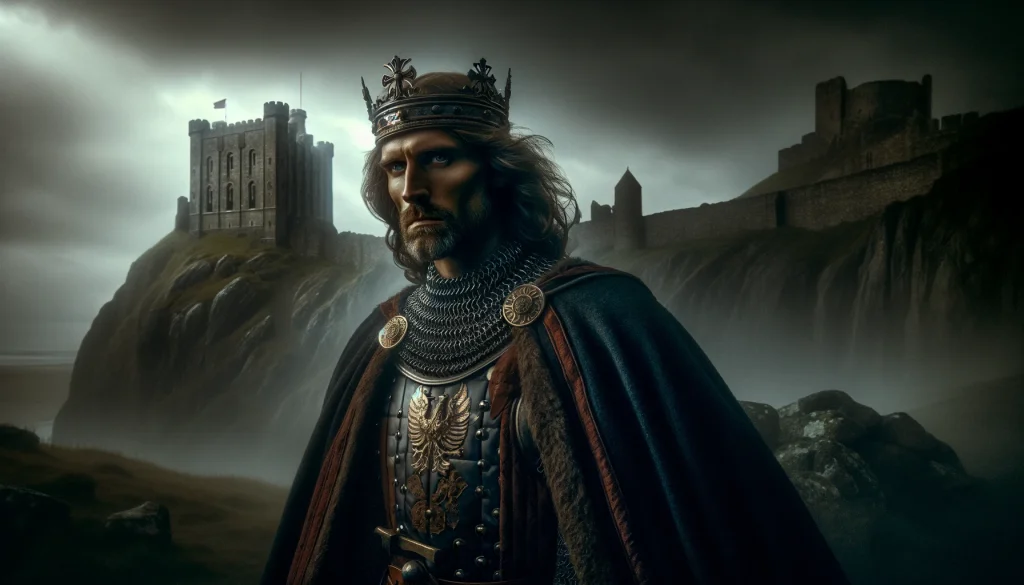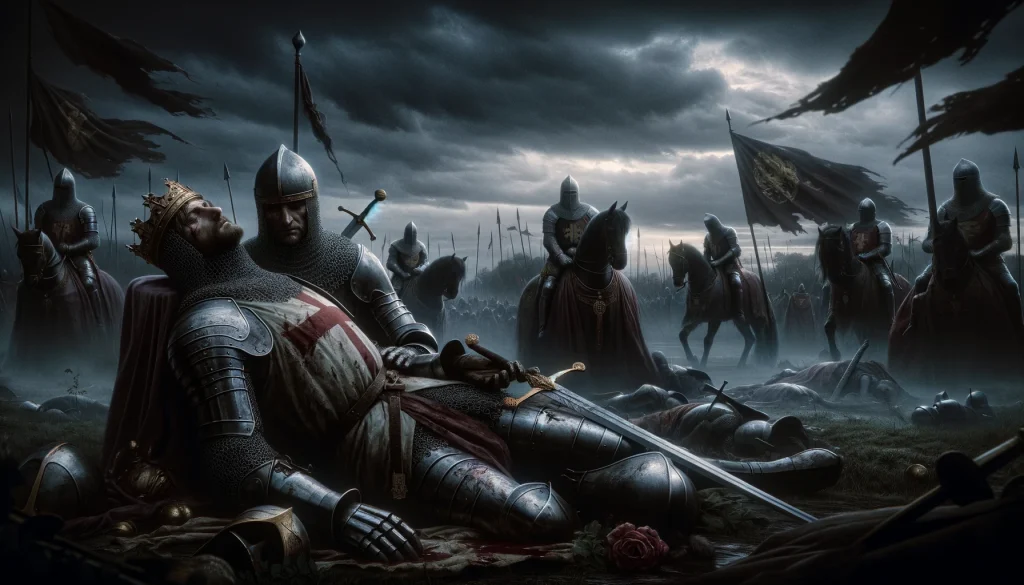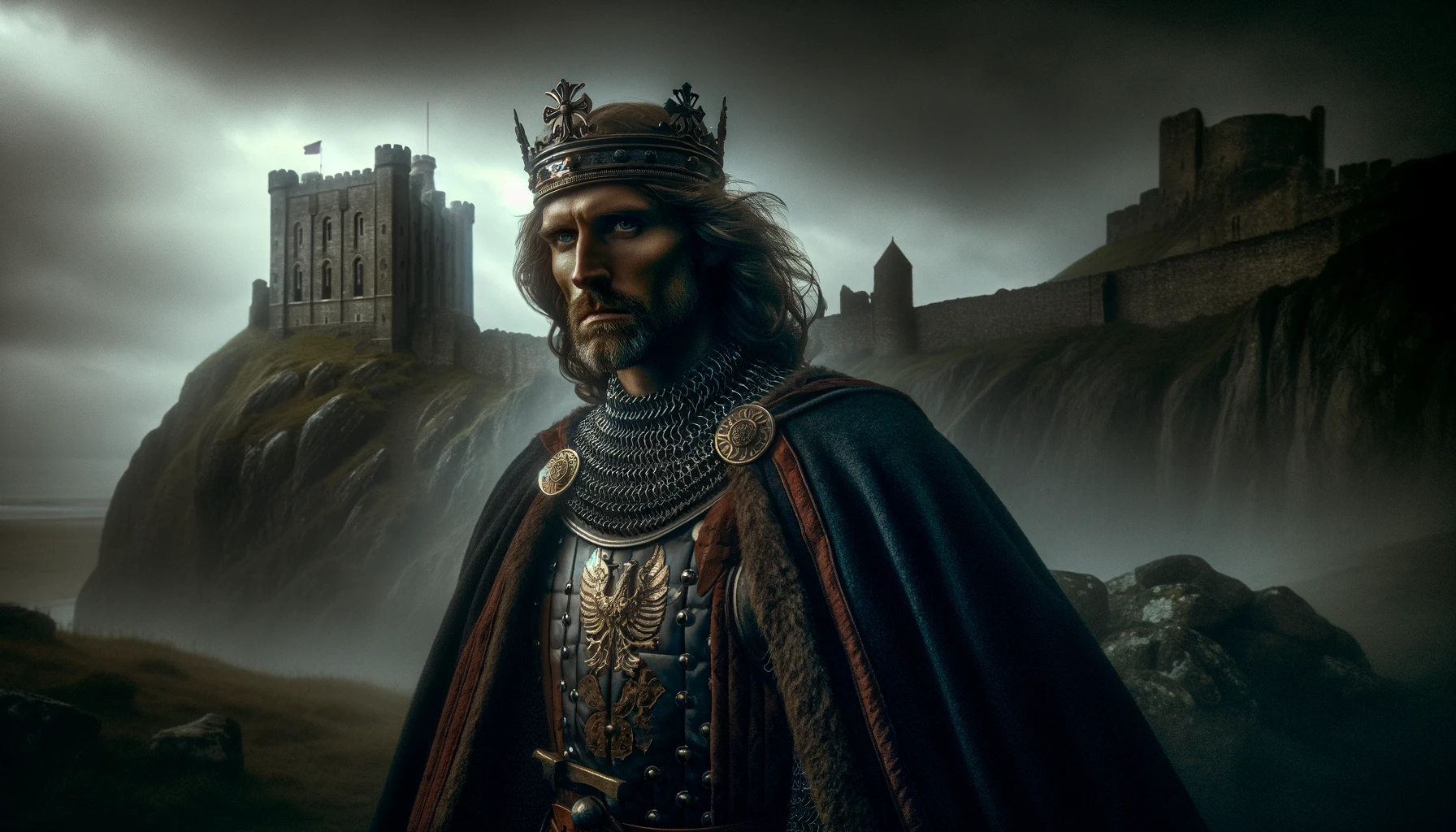Post-Galfridian myths refer to the body of Arthurian legends and narratives that evolved after the works of Geoffrey of Monmouth, particularly his seminal “Historia Regum Britanniae” (circa 1136), which played a pivotal role in popularizing the Arthurian legends across medieval Europe. These later stories expanded and diversified the Arthurian mythos well beyond Geoffrey’s initial framework, incorporating elements from French, Celtic, and Germanic traditions, among others. They introduced new characters, such as Lancelot and the Holy Grail, and developed existing ones, enriching the tales with themes of chivalry, romance, and moral allegory. This era saw the Arthurian legends flourish in literature, becoming an integral part of European cultural and literary heritage, influencing countless works and adaptations up to the present day.
King Arthurs Birth

In 1136, Geoffrey of Monmouth chronicled that in a bygone era, the wise and valiant King Uther Pendragon reigned over a tranquil and flourishing Britain, where the populace lived in contentment and safety. Yet, Uther was beset by personal woes; he had no offspring to succeed him or to bring joy to his life. Compounding his troubles was his intense affection for Ygraine, the spouse of the Duke of Tintagel.
Driven by his longing for Ygraine, Uther summoned all the nobility to a grand banquet at his castle. The Duke and Ygraine were among the attendees, but Uther’s relentless pursuit of Ygraine provoked the Duke’s fury, leading him to abruptly depart with his wife to Tintagel, an act that defied royal protocol.
Uther’s demand for their return was rebuffed, sparking a fierce conflict between his forces and those of the Duke. In his desperation, Uther sought the assistance of the wizard Merlin. Merlin agreed to aid Uther, but at a cost: any offspring from Uther’s union with Ygraine would be entrusted to Merlin. The King consented, and Merlin cast a spell that disguised Uther as the Duke, allowing him to enter Tintagel and be with Ygraine, who mistook him for her husband.

Their encounter resulted in a child, and after the Duke’s death in battle, Uther wed Ygraine. Nine months later, a son was born, named Arthur. True to his word, Uther handed over the child to Merlin, a decision that caused Ygraine immense sorrow, a pain she harboured against Merlin despite his assurances of the boy’s destined greatness.
The Sword in the Anvil
In the 12th century, the poet Robert de Boron introduced the Sword in the Stone story into Arthurian legend. After Arthur’s birth, Merlin discreetly took him to Sir Ector’s castle, a staunch supporter of the King. Arthur was raised there, believed to be Sir Ector’s illegitimate son, with his true royal identity unknown to all, including Sir Ector. Sir Ector had a son, Sir Kay, who, along with his friends, ridiculed Arthur, believing him to be a bastard. Consequently, Arthur grew up feeling ashamed of his origins, oblivious to his noble heritage.
Shortly after relinquishing his son, King Uther Pendragon fell gravely ill and passed away. The kingdom plunged into chaos for want of an heir, as various dukes and lords contested for the throne.

Amidst this strife, the nobility sought Merlin’s guidance. Having ensured Arthur’s safety, Merlin erected a sword in an anvil, positioned atop a stone in a churchyard in Westminster, London. The sword bore an inscription proclaiming that whoever could draw it would be England’s rightful king.
Despite many attempts by nobles, none could extract the sword, and it eventually faded from memory as England deteriorated further. During this time, Merlin befriended Arthur, mentoring him after his duties to Sir Ector, and instilling in him the belief that intellect was superior to physical strength. Though Arthur was physically unimposing, Merlin recognized in him the potential for wise and just leadership, capable of unifying and salvaging Britain.
Under Merlin’s guidance, Arthur matured, harnessing his potential for greatness and compassionate rule. At the age of fifteen, during an assembly at the Sword in the Stone, Sir Kay, followed by Arthur, attempted to withdraw the sword. Arthur succeeded, earning the acclaim of the onlookers and his subsequent coronation as King of England.
The Tale of Guinevere

The tale of King Arthur, his wife Guinevere, and the legendary sword Excalibur is one of the most enduring narratives in Western literature. As the story goes, after being crowned, Arthur quickly established himself as an unparalleled warrior and a wise king, thanks to the teachings of his mentor, Merlin. He led Britain to peace and prosperity, earning the love and respect of his people.
Despite his success and the tranquillity of his reign, Arthur longed for a companion. His encounter with an unnamed beautiful woman at his castle, though fleeting, left a lasting impression. However, it was his meeting with Guinevere that truly captivated him. Despite Merlin’s warnings of future sorrow, Arthur was smitten and determined to marry her. The union was celebrated throughout Camelot, bringing joy to the kingdom, except for Merlin, who foresaw the troubles it would bring.

In a fateful encounter at a misty lake, Merlin introduced Arthur to Nimue, the Lady of the Lake, who bestowed upon him the magical sword Excalibur. The sword, known for its unparalleled strength, was accompanied by an enchanted scabbard that protected its bearer from death in battle. This gift was significant as Arthur navigated the perils of his reign.
The wedding of Arthur and Guinevere was a grand affair, marked by joy and the gift of a round table from Guinevere’s father. This table symbolized equality and unity among Arthur’s knights, addressing Arthur’s concerns about rivalry among them. Each knight had a designated seat at the table, with one seat reserved for the greatest knight, a position that came with a deadly curse for any unworthy occupant.
For years, Arthur and Guinevere’s marriage was filled with love and happiness. They enjoyed a blissful life together until the arrival of Sir Lancelot. This new chapter in their lives would eventually lead to complex and tragic events, intertwining love, honour, and betrayal, and marking a pivotal moment in the Arthurian legends.
The Arrival of Mordred

This narrative is a part of the intricate and expansive Arthurian legends. In this segment, King Arthur, reigning wisely over a thriving Camelot, encounters a significant moment in his rule. The arrival of four strangers at the gates of his castle marks a turning point in the story.
The strangers are revealed by Merlin to be Arthur’s half-sisters, borne of Uther Pendragon, his father. Among them is Morgan le Fay, a character often portrayed as a sorceress with malevolent intentions towards Arthur. Merlin’s concern about her presence in Camelot underscores her ominous role in the legends.
The revelation of the boy as Arthur’s son, born from an unwitting union with his half-sister Morgause, introduces a complex and tragic element to the legend. This union, orchestrated by Morgan le Fay through magical means, sets the stage for future conflicts. The prophecy of betrayal by his own son adds a layer of foreboding to Arthur’s tale, highlighting the often-interwoven themes of fate, magic, and family in Arthurian lore.
These stories, rich in myth and symbolism, have been told and retold through centuries, each version adding its own nuances to the characters and their fates. They continue to be a significant part of Western literary heritage, fascinating readers with their blend of heroism, magic, and tragedy.
Merlin

The only being who captivated the attention of Merlin was Nimue, the Lady of the Lake. Her youth and extraordinary beauty, coupled with her magical nature, drew him in. His fascination with her evolved into an obsession, and he devoted his time to winning her affection. The kingdom’s most renowned wizard had fallen deeply in love.
Nimue, however, found his relentless pursuit bothersome and sought to escape his attention. Fearing the consequences of outright rejection, she feigned reciprocation, using this as an opportunity to learn his magical arts and secrets, hoping to eventually free herself from him.
On one occasion, Nimue suggested a stroll in the forest with Merlin to further her knowledge of his magic. Merlin, aware of the impending doom but blinded by love, agreed. Throughout their journey, Nimue eagerly absorbed his teachings. When they reached a cave known for its potent magic, Merlin, enchanted by her request, entered first. Seizing the moment, Nimue cast a powerful spell to seal the cave, trapping Merlin inside.
Merlin, despite his formidable powers, found himself unable to break the spell, as it was one of his own creations. Abandoned and powerless, Merlin was left confined in the cave, and legend has it that he remains trapped there to this day.
Lancelot

The popularity of Arthurian tales spread rapidly across Europe, and by the twelfth century, French author Chrétien de Troyes added a new depth to the Arthurian Legend. His works, known for their sensitivity, introduced much of the romantic elements associated with King Arthur, including the character of Lancelot.
With Merlin’s departure, the Lady of the Lake, Nimue, who had once resented Merlin, assumed the role of Arthur’s counselor. She respected Arthur greatly for his efforts in uniting Britain.
One day, Nimue approached Arthur with a request. She asked him to welcome Lancelot du Lac into his castle and train him in knighthood, knighting him when he desired. Arthur recognized Lancelot’s potential as a formidable warrior and agreed. Lancelot, eager to be knighted, was granted this honor shortly after his arrival. Following his knighting, Lancelot requested to serve as the Queen’s Champion, a role he excelled in, earning a reputation as Camelot’s finest knight and becoming a close friend to both Arthur and Guinevere.
However, Lancelot mysteriously disappeared, leaving the King and Queen concerned and puzzled. Years later, he returned, looking worn and weary. He recounted his adventures to Arthur, including his encounter with the city of Corbenic, ruled by the Fisher King, Pellés. Lancelot heroically defeated a dragon there and was shown the Holy Grail during a feast held in his honor. Pellés revealed the Grail’s lineage from Joseph of Arimathea, a claim Arthur initially doubted.
Lancelot also confessed his unfulfilled love for Guinevere, revealing the torment it caused him, leading to his self-exile and a period of madness. In Corbenic, he was united with Elaine, King Pellés’ daughter, with whom he fathered a son, Galahad. However, Lancelot was anguished by Elaine’s deceptive means to win his affection.
During their conversation, Arthur and Lancelot were urgently called to the riverbank, where they found a barge carrying the body of a dead woman. To Lancelot’s despair, it was Elaine, who had taken her own life.
The Quest for the Holy Grail

The Holy Grail has emerged as a pivotal element in the Arthurian sagas, with its links to Arthur traced back to some of the earliest legends. Its prominence as a Christian emblem particularly soared during the twelfth and thirteenth centuries, especially with the emergence of the Vulgate Cycle by an anonymous author.
Galahad, renowned for his purity, became a central figure. On a Pentecost eve, a mysterious woman led Sir Lancelot to a nunnery, where he encountered his cousins, Sir Bors and Sir Lionel, and knighted a young man who resembled him. Bors speculated that the youth was Lancelot’s son with Elaine.
Upon Lancelot’s return to Camelot, an inscription was found above the Siege Perilous, indicating the imminent arrival of its destined occupant. During a meeting at the Round Table, Galahad, Lancelot’s son, claimed his place at the Siege Perilous. Following his arrival, a vision of the Holy Grail materialized, signalling the knights to embark on a quest for it.
Galahad, surpassing all knights in virtue, led the quest alongside Sir Bors and Sir Perceval. They journeyed to Corbenic, where Galahad’s lineage was affirmed through a miraculous restoration of a broken sword. During a trance, Galahad was instructed to take the Grail to Sarras in the Middle East.
The trio found the Grail aboard their ship and transported it to Sarras. There, the Grail ascended to Heaven, out of mortal reach. Of the three knights, only Sir Bors returned to Camelot. Sir Perceval, profoundly affected, chose a hermit’s life, while Galahad passed away shortly after, having fulfilled his pure-hearted mission.
Lancelot and Guinevere Trapped

The narrative of Arthur, Lancelot, Guinevere, and Mordred is a classic element of Arthurian legend, rich in drama and tragedy. After the death of Galahad, Lancelot remained Arthur’s finest knight. Despite being aware of Lancelot’s love for Queen Guinevere, Arthur stayed silent, valuing Lancelot’s loyalty and friendship. However, this peace was disrupted when Mordred informed Arthur of Lancelot and Guinevere’s secret meeting.
Reluctantly, Arthur agreed to Mordred’s reminder of the law against adultery. A trap was set, resulting in Guinevere’s capture and subsequent trial and sentencing to death by fire. In a daring rescue, Lancelot saved Guinevere, fleeing with her while Arthur’s forces were engaged.
The Death of Arthur

Sir Thomas Malory’s fifteenth-century work “Le Morte d’Arthur” (“The Death of Arthur”) is a seminal retelling of these events. In Malory’s account, Arthur pursued the fleeing lovers to Lancelot’s castle in Wales, besieging it for months before Guinevere was returned and Lancelot exiled to France.
Arthur’s pursuit of Lancelot to France, leaving Mordred in charge, set the stage for further betrayal. Mordred declared himself king and took Guinevere. Arthur returned to confront Mordred, leading to a fateful and catastrophic battle. During this battle, Arthur killed Mordred but was mortally wounded himself.
Arthur’s final request was for Excalibur to be returned to the lake. As he lay dying, three Fairy Queens took him to Avalon, where legend holds that he remains, destined to return in Britain’s hour of need.
These tales, woven with themes of loyalty, betrayal, love, and destiny, continue to captivate and resonate through the ages, embodying the timeless allure of Arthurian legends.
